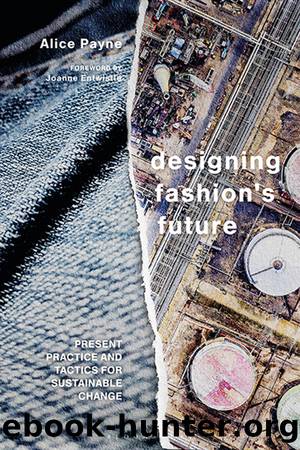Designing Fashion's Future by Alice Payne

Author:Alice Payne
Language: eng
Format: epub
Publisher: Bloomsbury Publishing
Figure 6.4 Sustainable fashion in motion â designer Nhu Chauâs upcycled denim (© 2019 T. J. Thomson).
Design through upcycling â creating garments of higher value, from lower-value or waste materials, a reactive approach to CE. This may include upcycling of post-industrial textile offcuts or of worn-out post-consumer garments. Upcycling worn garments into other garments is often an artisanal and laborious process and has a long lineage in fashion practice extending from the poetics of Martin Margielaâs deconstructions, through to the more sustainably focused artisanal approaches of small-scale independent designers (discussed in Binotto and Payne 2017, Atalay Onur 2020). Figure 6.4 shows designer Nhu Chauâs upcycled denim made from the hem offcuts from a clothing repair service. For an in-depth discussion of the remanufacturing process and its implications, see Dissanayake and Sinha (2015).
Design for cyclability â designing a garment that can be effectively recycled at end-of-life, paying attention to how it may be disassembled and its materials recovered. This may include garments made from 100 per cent polyester to allow for mechanical recycling, or 100 per cent C2C-certified cotton, which can be safely biodegraded. Following Goldsworthy (2014), design for cyclability is a proactive strategy, in that it is an intervention to stop waste occurring. Related strategies include design to reclaim materials, design for disassembly and design for mono-materials. For further discussion of design for disassembly, see Gam et al. (2011).
Design for biodegradability â a more specific form of design for cyclability, this refers to items that are designed to safely biodegrade. This approach connects to design for different speeds/metabolisms (see Goldsworthy, Earley and Politowicz 2018). Examples include OATs compostable shoes, working with the C2C concept; C2C certification is designed to ensure the garments can be biodegraded.
Design for sustainable use
Design for sustainable use involves a diverse set of design strategies that seek to address areas for which users have the primary responsibility: the impact of the myriad decisions around garment acquisition, use and eventual disposal. In a CE, the aim should be to keep garments in active use as long as possible (Niinimäki 2017). Many of these design strategies seek to address or realign the wearer practices formed from what Elizabeth Shove (2003) terms the âinconspicuous habitsâ of daily life. Although the overarching aim of the strategies may be to reduce environmental impact, the application of them varies from market-based solutions in new business model design, through to community-focused practices that operate outside the market (e.g. Fletcherâs Local Wisdom/Craft of Use project 2011, 2016).
Design for product-service systems (PSS) â design for PSS involves the design of services that prolong the useful life of clothing. Examples include âaccessâ business models such as renting and sharing, and services such as remodelling and repairing. Different PSS approaches meet different needs: as Armstrong et al. (2015: 38) note, renting and swapping appealed to younger consumers, whereas services focused on product satisfaction such as redesign, repair, customization or styling consultancy were most suited to older consumers. Product-service systems, as the name suggests, are at both system level and product level of change, as new business models are required to develop services for users.
Download
This site does not store any files on its server. We only index and link to content provided by other sites. Please contact the content providers to delete copyright contents if any and email us, we'll remove relevant links or contents immediately.
Wonder by R.J. Palacio(8430)
Mastering Adobe Animate 2023 - Third Edition by Joseph Labrecque(3720)
Unlabel: Selling You Without Selling Out by Marc Ecko(3574)
Ogilvy on Advertising by David Ogilvy(3485)
Hidden Persuasion: 33 psychological influence techniques in advertising by Marc Andrews & Matthijs van Leeuwen & Rick van Baaren(3454)
Drawing Cutting Edge Anatomy by Christopher Hart(3440)
The Pixar Touch by David A. Price(3347)
POP by Steven Heller(3297)
The Code Book by Simon Singh(3057)
The Art of War Visualized by Jessica Hagy(2932)
Slugfest by Reed Tucker(2924)
The Curated Closet by Anuschka Rees(2897)
Rapid Viz: A New Method for the Rapid Visualization of Ideas by Kurt Hanks & Larry Belliston(2815)
Stacked Decks by The Rotenberg Collection(2796)
365 Days of Wonder by R.J. Palacio(2737)
The Wardrobe Wakeup by Lois Joy Johnson(2717)
Keep Going by Austin Kleon(2682)
Tattoo Art by Doralba Picerno(2583)
Tell Me More by Kelly Corrigan(2579)
